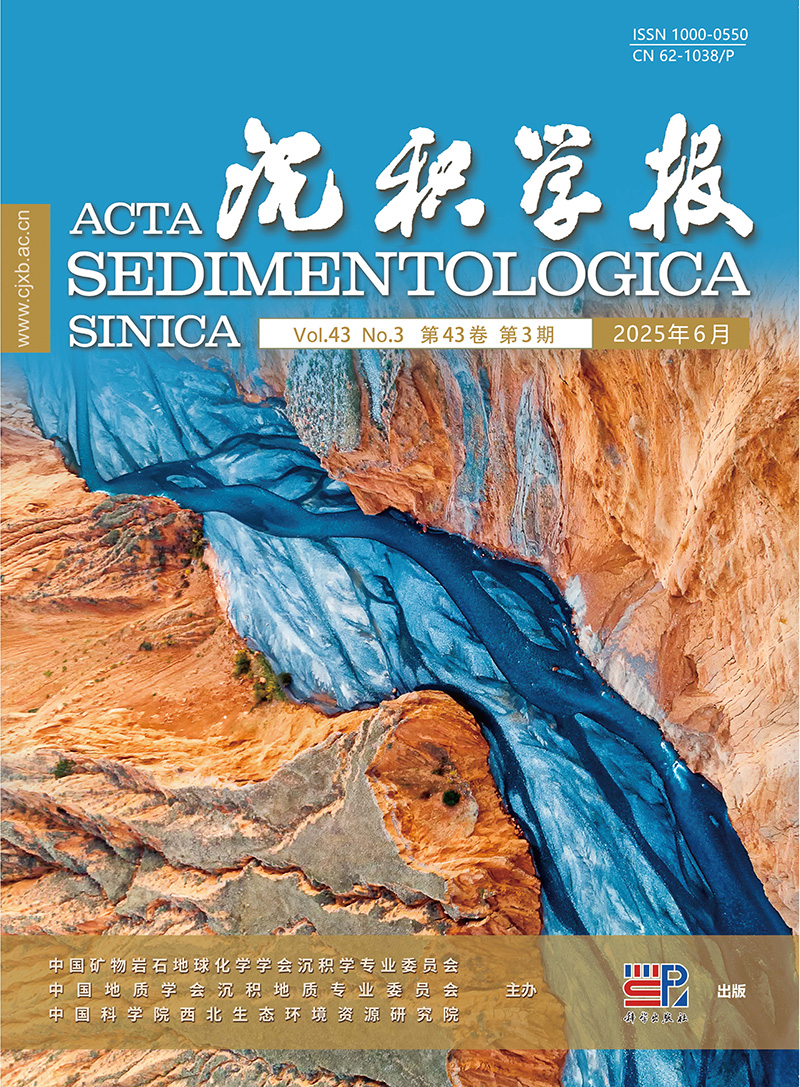HTML
-
砂质辫状河是一种常见的河流类型,广泛见于太古代至今的所有地层记录中[1⁃3],可形成大规模、宽带状、泛连通的优质储集体。在我国鄂尔多斯盆地、准噶尔盆地、塔里木盆地、松辽盆地、渤海湾盆地及国外多个含油气盆地内均发现了大规模砂质辫状河成因的油气储层[4⁃11]。大量开发实践表明:砂质辫状河储层虽然规模大且整体泛连通[12],但其内部构型特征复杂、非均质性强,存在多个层次、多种类型的高渗条带和夹层[13⁃15],导致砂质辫状河储层在开发初期往往产量较高,但进入注水开发阶段后普遍存在见水快、含水率上升快、开发措施调整效果差等问题,到开发后期,含水率高的同时,大量的剩余油气仍富集于储层内部,严重制约了砂质辫状河储层高效开发[16⁃21]。基于现代沉积与露头观察解剖、水槽模拟、沉积数值模拟等技术的研究已经表明,辫状水道的频繁迁移活动驱动心滩的反复形成、改造、重塑过程,导致辫状河沉积构型十分复杂,并体现为心滩形态与分布样式多样,心滩内部增生体形态各异且复合关系复杂、辫状水道不同程度侵蚀心滩并形成复杂的空间结构样式[10,13,22⁃33]。大量的研究表明,砂质辫状河储层内部不同级次的构型界面与构型单元控制的储层内部单元叠切关系、连通性及储层质量差异是主导地下流体运动特性与剩余油富集的关键因素之一[16⁃20]。因此,充分考虑砂质辫状河形成与演化过程的复杂性并建立贴近地下储层实际的沉积构型模式对于深化辫状河沉积学理论并指导地下储层构型解剖与剩余油气资源挖潜具有重要意义。
长期以来基于现代沉积观察与探地雷达浅层探测研究及水槽与沉积数值模拟研究主要聚焦于砂质辫状河表层沉积地貌特征与沉积样式研究,构建了较为丰富的沉积模式并获得了大量的构型单元定量规模数据[24,26,34⁃40]。然而,由于砂质辫状河水道网络的高频活动和强烈的侵蚀、改造、沉积作用,最终保存在地层记录中的辫状河沉积构型及其构型单元规模与定量关系明显有别于尚处于活跃状态的现代辫状河浅表部位。差异主要体现为活跃沉积最终保存程度较低(<50%)、心滩保存比例较低、沉积构型要素保存不完整且多以侵蚀改造后的残余沉积存在[30,41⁃43]。因而,从现代沉积中观察到的心滩、辫状水道难以完整地保存在地下储层中,基于活跃辫状河浅表沉积特征或沉积模拟过程中的地貌特征构建的沉积模式及获取的定量规模信息难以有效地指导地下储层表征。相比于现代沉积及模拟沉积地貌,野外露头更接近地下储层,然而由于露头往往出露条件有限、系统性差且形成背景复杂,难以充分支撑储层构型模式与定量规模研究[13,25,44⁃48]。
为了建立贴近地下砂质辫状河储层的构型模式,并建立构型单元定量规模与关系模型,需从长期演化过程分析的角度出发,明确演化过程中辫状水道与心滩的迁移演化模式与侵蚀改造及保存规律,据此建立构型模式,并提取已保存在沉积记录中的沉积构型要素规模以构建可靠的定量规模与相关模型。本文参考现代辫状河沉积背景条件设定水槽沉积模拟装置和边界条件并开展砂质辫状河水槽模拟实验研究。实验过程中,采用三维激光扫描仪按固定时间间隔获取实验沉积地貌数据,并据此重构三维数字化沉积构型模型,以分析实验辫状河长期连续演化过程及其最终保存的沉积构型特征及定量规模。通过细致的沉积演化过程分析,明确了砂质辫状河形成过程、水道与心滩协同演化模式、沉积构型模式及构型单元定量规模,为地下砂质辫状河储层表征提供可靠的模式指导和定量规模与定量关系约束。
-
为模拟砂质辫状河的形成与演化过程,设置了一套水槽模拟装置(图1),该装置由砂质底床、循环供水泵、螺杆式定速供砂器、水位控制边界、储水槽、三维激光扫描仪及延时摄影相机构成。砂质底床长8.5 m,宽1.1 m,以天然河砂铺设并轻微压实,提供了足够的模拟空间(图2),底床高差5 cm。模拟过程中,循环供水泵从底床末端水槽抽水并泵送到水砂混合漏斗中,与螺杆式定速供砂器提供的砂混合,从水槽底床左侧边界进入砂质底床发生沉积。水位控制边界限定了砂质底床末端水位高低,以保证模拟过程中不因水位波动影响实验辫状河沉积。为了获取沉积演化过程中的沉积地貌数据,在多个站点利用三维激光扫描仪扫测实验辫状河地貌,获取高精度、高密度三维点云数据。延时摄影相机从多个视角以1 s为间隔拍摄实验辫状河图像。
-
参考现代辫状河沉积背景条件,设定了模拟边界条件(表1)。底床成分与模拟中供应的砂质均为天然河砂,其粒度中值为0.75 mm,两者成分相似保证模拟过程中不因砂质沉积物成分与粒度对河流沉积演化造成干扰。砂质底床坡降为0.05 m,坡长8.5 m,坡度约为5.9,经多轮预实验测试,该坡度适于砂质辫状河模拟。在模拟过程中,供水量保持在1.5 L/s,实验实测水流速度大致为0.1 m/s,经预实验测试后,将供砂率设定为3 g/s,以确保模拟过程中上游边界处不发生砂质堆积或异常下切。为保证激光扫描仪扫测精度,以1 h为间隔开展实验,每个期次结束后排干底床内的明水,开展多站联合激光扫描,记录沉积过程中的地貌特征及其演变过程。本实验共进行48个周期的模拟,在平缓的砂质底床上再现了一条典型砂质辫状河逐步形成并持续演化的过程。从实验时长与稳定边界条件的前提出发,本实验模拟的辫状河可类比自然界冲积平原上的单一辫状河,在地下储层中可对应单砂层内部的辫状河单砂体储层。因而,从油气藏开发的角度出发,实验辫状河构型特征可对应单砂体内部构型。
参数类型 参数值 参数类型 参数值 水槽长度 8.5 m 水槽长宽 8.0 m×1.1 m 水流流速 0.1 m/s 水流流量 1.5 L/s 底床坡度 0.05 m/8.5 m(比降约5.9 ) 砂质沉积物来源 天然河砂 主要砂质成分 中砂、细砂 沉积物粒度中值 0.75 mm 供砂量 3 g/s 监测方式 激光扫描 单期时长 1 h 模拟步数/期次数 48步/期 Table 1. Experimental boundary conditions
-
实验过程中采集的激光点云数据是具有三维坐标、图像信息的离散点云,无法直接用于沉积学分析和构型解剖。实验数据的处理分为三个步骤,首先,采用Scene软件对单期次多站点云数据进行融合处理,形成坐标系统一的点云数据;随后,提取实验辫状河区域内点云,并进行点云数据优选和网格化,形成各期次模拟后的数字化沉积地貌数据与正射投影图像数据;进一步地,对沉积地貌数据集进行去趋势处理,排除底床顺源高程差异,突出辫状河心滩与辫状水道形态、规模信息并用于沉积演化过程分析;最后,参考Straub et al.[49]提出的数字地层重构方法,开展沉积演化过程回溯,计算经过反复侵蚀改造后最终保存在沉积记录中的期次边界,并据此重构模拟辫状河三维空间结构模型,该模型用于沉积构型模式研究与沉积构型单元定量规模测量分析。
1.1. 实验装置
1.2. 边界条件
1.3. 实验数据处理方法
-
在实验初期(第1~16模拟期次),水流携带沉积物进入砂质平缓的砂质底床上发生沉积并逐步演化形成一条典型的砂质辫状河(图3)。在辫状河的逐步形成过程中,砂质沉积物主要以底床搬运方式顺源推进,首先形成初始的心滩和初步的辫状水道分流(图3a、图4),随着砂质沉积物向下游迁移,心滩数量增加,辫状水道流程延长、数量增加、弯曲度变大(图3b~c),这一过程中,已形成的上游心滩也在快速演化。以第9期形成的心滩Bar-A为例,在经历3个周期的模拟后,该心滩已经被后续的辫状水道侵蚀切割,由半对称的大规模复合心滩转变为多个近对称的小规模心滩,辫状水道由单侧环绕转变为多条交织环绕(图3c~d),到第12期模拟结束,该心滩已发生明显的顺源迁移,形成大规模复合心滩。基于辫状河初始形成过程的观察表明,底床搬运是砂质辫状河形成过程中的基本动力机制,这一机制决定了砂质辫状河整体水浅流急,无法形成长期稳定的水道,其演化总是伴随着底床沉积物迁移堆积、心滩增生、辫状水道迁移等复杂的迁移变化过程,且河网与心滩演变速度快、频次高。
需要注意的是,初始形成的心滩主要由上游辫状河道集中供给而成,整体呈现朵状特征(图3,4),与后期遭受辫状水道改造后的心滩存在较大差异。典型的初始心滩Bar-B(图4)在形成过程中先由上游辫状水道供给形成朵状雏形并持续顺源增大(图4a1~a2,b1~b2),随后,由于心滩顶部堆积沉积物出露水面,心滩增生转向侧缘(图4a3~a4,b3~b4),最后该心滩发生退积和侧积,转而在心滩上游及侧缘发生增生(图4a5~a6,b5~b6)。这类初始心滩在随后的沉积演化过程中往往被部分破坏,并最后残存于辫状河底部。由于心滩形成过程中存在进积、退积及侧积,其内部构型较为特殊,有别于辫状河演化成熟阶段形成的心滩。
-
不同于辫状河形成初期沉积物持续顺源推进的特征,一旦辫状河形成并进入持续演化期,辫状水道与心滩整体样式大致维持稳定,但辫状水道与心滩的协同演化仍连续进行,表现为辫状水道频繁迁移演化,心滩也随之逐步发生增生、遭受改造甚至被彻底侵蚀,从而形成十分复杂的沉积构型,多数心滩和辫状水道沉积难以被完整保存。因而,明确辫状水道与心滩协同演化模式,是深入揭示地下储层沉积构型的必要前提,据分析,辫状水道与心滩的协同演化机制主要包括三类。
-
辫状水道连续侧向迁移现象常见于心滩侧缘,主要位于水道弯曲部位,由上游供水与心滩表面水流汇入共同控制形成二次流(secondary flow),导致在局部河段发生水道单向环流,引发辫状水道局部段发生凸岸侵蚀和凹岸堆积。在实验过程中辫状水道连续侧积现象十分常见,并主导心滩的侧向增生。以第15~19期次模拟过程中局部河段为例(图5),心滩Bar-C侧缘较宽的辫状水道Ch-A受到心滩分布控制发生连续侧积,侵蚀该水道凸岸心滩,并引发凹岸心滩不断侧积,形成侧积尾翼(图5)。在辫状水道连续侧向迁移过程中,其上游段整体维持稳定,但下游快速扫动(图5a~c)并最终取直改道(图5d),在这一过程中侧积尾翼甚至充填了因下游河段快速迁移而废弃的河道(图5d)。

Figure 5. Continuous lateral migration and chute cutoff of braided channels and lateral growth of braided bars
辫状水道连续侧积是其一侧心滩遭受侵蚀而另一侧心滩发生侧积的主导因素,这一现象多发生在心滩中游侧缘。在连续侧向迁移过程中,辫状水道上游基本维持稳定而下游快速迁移,最终导致下游取直改道,心滩尾部也往往因下游水道迁移废弃的河道被快速充填而与更下游心滩复合(图5d)。
不同于曲流河侧向迁移过程中河道本身的高度稳定特征,辫状水道的侧积往往导致其下游河段发生快速的迁移和废弃—充填沉积。受辫状水道连续侧积影响,其凸岸一侧心滩多遭受深切而难以完整保存(图5c~d);而其凹岸一侧形成的增生体拼合于原有心滩侧缘,且新形成的增生体侧积方向明显有别于原有心滩内部增生体(图5d)。
-
在辫状水道网络中,局部河段的变迁易引起下游河段废弃,形成废弃充填沉积并与邻近心滩拼接复合,从而导致心滩迅速增生。以第20~21期次模拟过程中局部河段为例(图6),在第20期模拟结束后心滩Bar-D一侧较大规模辫状水道Ch-B因其上游水道变迁而流量锐减(图6a),在第21期次模拟过程中,该辫状水道被迅速充填并与心滩Bar-D拼合形成更大规模的复合心滩(图6b)。
大规模或主干型辫状水道废弃后,其下游多条水道也可能同步废弃。如Ch-B废弃地充填的同时,还存在多条同步废弃的水道,这类水道主要是心滩中下游中央部位具有汇流特征的小规模水道或水道组合,其主要成因是心滩表面沉积物顺水流向下游搬运沉积,这类废弃水道充填造成心滩顺流增生或加积,主要影响心滩中下游中央部位厚度(图6c),这类废弃河道充填广泛存在于心滩中下游部位,图5所示的连续迁移辫状水道下游也存在多条这类废弃河道充填沉积。大规模或主干型河道废弃过程中,也可能形成小规模、短时存续的取直水道(Ch-D)(图6b,c),这类水道往往形成于大规模或主干型水道废弃末期,难以持续稳定存在,在后续的沉积过程中易被充填。
-
在辫状河沉积演化过程中,同一河段多条辫状水道往往因相向迁移而汇水,由于河床内水流几乎完全汇集于一条大规模水道内,水动力骤然增强,可大面积侵蚀其下游心滩,并在短时间内局部或整体重塑下游心滩形态(图7)。
以第25~27期模拟过程中局部河段为例,在第25~26期次模拟中,心滩Bar-E、Bar-F仅受到辫状水道迁移或取直冲刷轻微改造,主要的辫状水道Ch-E和Ch-F维持稳定,心滩Bar-F受辫状水道Ch-G和Ch-I的废弃与取直下切而发生形变,但河段整体特征维持大体稳定(图7a,b)。在第27期次模拟中,心滩Bar-E上游辫状水道发生汇聚,形成大规模辫状水道Ch-J并冲刷心滩Bar-E,导致该心滩大部区域被深切冲蚀。被侵蚀的沉积物顺水流搬运至下游并导致心滩Bar-G的形成和心滩Bar-F的迎水生长(图7c)。仅在1个模拟期次内,辫状水道汇水冲刷导致心滩Bar-E被整体重塑,而心滩Bar-F发生局部重塑(图7)。
对整个实验的观察结果显示,辫状水道汇水冲刷作用发生频次较高、维持时间较短但对辫状水道网络与心滩的重塑作用强烈。距离汇水点越近,水流冲刷作用越强,可导致心滩主体被完全冲蚀,冲刷点下游方向则在短时间内迅速堆积被冲刷搬运的沉积物,因而下游河段辫状水道数量增加、水深变浅(图7c)。汇水冲刷作用的范围通常在长1~2个复合心滩长度的河段内发生,并不直接影响下游河段沉积特征。因此,辫状河沉积演化过程中,普遍存在局部河段快速演变,整体水道—心滩样式维持稳定的特征。
-
针对实验过程的系统观察表明,心滩沉积演化过程中普遍存在形成、生长、遭受侵蚀、残存等过程,在这一过程中心滩规模随之有规律地变化。基于去趋势沉积地貌图对实验辫状河沉积演化过程中存在的典型心滩进行连续追踪与规模测量(图8),取得以下结果:(1)单个心滩的形成过程较为迅速,通常在1~6个模拟期次内持续生长至最大规模,随后在3~8个模拟期次内遭受连续侵蚀而规模减小(表2),最终仅小部分得以最终保存或被完全侵蚀(图8);(2)部分心滩形成过程中经历侵蚀、生长、再侵蚀,或同时遭受侵蚀和生长,其规模存在一定程度的波动,但其最终保存情况不变;(3)心滩长宽及面积变化大体保持一致,但其长宽比存在一定程度的波动,心滩长宽比平均为2.8,与现代辫状河测量结果相近[24,35,50],多数心滩在演化过程中维持稳定,但部分心滩在其演化末期受到较大幅度侵蚀后存在长宽比增大现象。针对11个典型心滩演化过程完整追踪的测量结果显示,心滩形成后受到辫状水道的进一步侵蚀改造,仅18.66%~57.41%的分布区域残存于沉积体中(表2),平均最终保存率为36.28%。
心滩编号 沉积河段Y/m 沉积期次 最大面积/m2 最终面积/m2 心滩最终保存率(最终面积/最大面积)/% A 4.0~5.8 5~14 0.98 0.24 24.49 B 2.7~5.2 10~15 0.79 0.28 35.44 C 5.3~7.0 15~24 0.70 0.31 44.29 D 3.0~5.9 16~30 1.34 0.25 18.66 E 6.3~7.6 19~26 0.54 0.20 37.52 F 1.4~3.7 20~28 0.87 0.16 22.09 G 4.0~6.1 26~37 0.87 0.27 30.55 H 6.0~7.5 29~44 0.65 0.27 41.98 I 2.8~4.5 35~40 0.62 0.30 47.91 J 5.1~6.8 37~48 0.95 0.55 57.41 K 3.8~5.4 40~46 0.73 0.28 39.16 Table 2. Depositional duration, area and, preservation ratio
2.1. 实验辫状河形成过程
2.2. 辫状水道与心滩连续协同演化机制
2.2.1. 辫状水道连续侧向迁移主导心滩侧积增生
2.2.2. 辫状水道废弃充填并与心滩拼接复合
2.2.3. 辫状水道汇水冲刷与心滩重构
2.3. 心滩沉积规模变化规律与保存特征
-
在辫状水道与心滩协同演化模式分析的基础上,利用序列化沉积地貌数据重构实验辫状河三维数字化沉积构型模型并提取典型部位构型剖面,再现了实验后最终保存在沉积记录中的砂质辫状河沉积构型特征(图9)。需要指出的是,水槽沉积模拟产生的辫状河规模较小,按固定时间间隔进行三维激光扫描并重构的模拟辫状河三维构型模型内主要包含了复合砂体、单砂体及单砂体内部增生体(Miall分级为5~3级)3个级次的构型单元信息。
-
根据辫状水道形态、规模、叠切样式等特征差异,实验结束后保存在最终沉积记录中的辫状水道(4级构型单元)主要分为三类,包括复杂叠切水道(图9,类型A)、下切水道(图9,类型B)、孤立水道(图9,类型C)。
复杂叠切水道发育程度最高,由多期辫状水道侧向迁移沉积与垂向叠切而成的增生体(4级构型单元)构成,其宽度可达单一辫状水道的2~10倍,平均宽0.28 m、深0.12 m。复杂叠切水道内部一般存在3~15期水道叠切过程(图9b1~b4),单期水道整体较厚,在横切剖面上表现为高强度叠切,而在平面上则表现为多条流向不同、规模各异、河段长度参差的水道在某一河段反复迁移活动(图7)。复杂叠切水道之间也存在侧向叠切或拼接,导致其宽度远大于剖面上的心滩沉积宽度(图9b1~b4)。在顺源方向上,复杂叠切水道延伸叠切强度较低(图9c1~c2),其叠切过程与不同模拟期次内不同辫状水道深度、迁移活动强度及方向相关。
下切水道多形成于辫状河模拟的初期阶段,由水流汇集深切后充填而成,侵蚀底床并随后充填(图9b2,b4,c1,c2,类型B)。下切水道仅局部存在,其深度与复杂叠切水道相当,但宽度明显小于复杂叠切水道。
孤立水道在切物源剖面上发育程度较低,属于短时存在的辫状水道(图9b2~b3,类型C),多由新形成的辫状水道快速废弃充填形成。
统计剖面上辫状水道面积占比可知,以复杂叠切辫状水道为主的水道沉积占比可达57.9%,这表明在最终保存的辫状河沉积体内,河道占比高于心滩。
-
剖面构型分析表明,实验辫状河内部心滩(4级构型单元)存在5方面特点:其一,心滩多被辫状水道切割,规模较小,形态破碎(图9),与现代沉积或实验地貌中识别出的心滩宽度相比显著偏小;其二,心滩一般由多个垂向加积体构成(3级构型单元),平均单个心滩内包含3~8个期次内形成的多个加积体,加积体顶底界面通常平缓(图9),仅少量心滩内部增生体存在底平顶凸的特征(图9b4);其三,剖面上心滩沉积占比仅为42.1%,显著低于现代辫状河观察结果;其四,辫状河底部心滩往往连续性更好、规模更大,受辫状水道侵蚀改造程度较低,而中上部心滩沉积比例偏低,且被辫状水道侵蚀改造程度更高(图9);其五,在垂向上,心滩增生体之间往往存在密集发育的增生体界面,显示该处存在连续多期薄层披覆泥岩沉积,为泥质夹层。
3.1. 辫状水道沉积构型特征
3.2. 心滩沉积构型特征
-
以重构的模拟辫状河三维空间结构模型为基础,截取切物源剖面并测量最终保存在实验辫状河沉积体内部的构型单元及增生体单元的定量规模,建立了构型单元及其内部增生体定量规律。
-
以重构的多条构型剖面为基础,测量相邻的辫状水道—心滩组合18个、心滩26个、辫状水道33个、心滩内部增生体180个、水道内部123个,并按测量剖面统计其平均值(表3),结果表明:(1)辫状水道沉积占比介于44.81%~66.20%,平均为57.9%,是辫状河沉积的主体;(2)心滩沉积占比为42.1%,单一心滩平均宽0.258 m、厚0.013 m,宽厚比为19.8;(3)单一心滩内平均发育5.7~12.4期增生体,增生体平均宽0.127 m、厚0.005 m,宽厚比为25.4;(4)水道沉积平均宽0.268 m、厚0.019 m,宽厚比为14.1;(5)单一水道内平均包含4.2期增生体,平均宽0.137 m、厚0.010 m,宽厚比为13.7。
测量参数 剖面面积 水道沉积占比 心滩平均厚度 心滩平均宽度 心滩平均增生体数量 心滩增生体平均厚度 心滩增生体平均宽度 水道平均厚度 水道平均宽度 水道内平均增生体数量 水道增生体平均厚度 水道增生体平均宽度 /m2 /% /m /m 层/心滩 /m /m /m /m 层/水道 /m /m L1-R1 0.033 66.20 0.012 0.133 5.7 0.004 0.109 0.018 0.190 4.1 0.01 0.094 L2-R2 0.036 62.08 0.014 0.307 11.6 0.005 0.108 0.021 0.300 3.4 0.011 0.192 L3-R3 0.034 56.47 0.013 0.326 7.5 0.005 0.142 0.019 0.219 3.7 0.009 0.136 L4-R4 0.029 44.81 0.014 0.266 12.4 0.004 0.147 0.019 0.362 6.3 0.01 0.124 所有剖面平均 0.033 57.90 0.013 0.258 9.3 0.005 0.127 0.019 0.268 4.4 0.01 0.137 Table 3. Scale of sedimentary architecture elements measured from transverse sections
-
根据测量所得定量规模数据,明确了砂质辫状河沉积体内部心滩、水道及两者内部增生体规模的定量关系(图10)。结果表明:(1)心滩与辫状水道宽度存在良好的正相关关系,线性拟合优度为0.716(图10a),两者厚度也存在正相关关系,但由于部分水道垂向叠切或水平叠切拼合,其厚度变化幅度较大,线性拟合优度仅为0.341(图10b);(2)心滩、水道的宽度与厚度整体呈正相关关系,但由于部分心滩被侵蚀程度高、叠置期次较多、少数水道侧向叠切拼接程度异常高,线性拟合优度仅为0.378、0.227(图10c~d);(3)心滩内部增生体的宽度、厚度也存在一定的正相关关系,部分增生体因遭受较强的侧向侵蚀切割,残存下来的增生体厚度较大、宽度较小;(4)水道内部增生体大致可分为3类,除主体样本外,存在沉积动力弱、侵蚀改造强度较低的厚层侧向增生体和沉积动力较强、侵蚀改造强度高的两类规模异常的增生体。
需要指出的是,水槽模拟形成的辫状河规模较小,其沉积过程也受限于水槽测量固定边界,因而测量得到的沉积构型单元定量规模与自然界辫状河可能存在一定程度的差异,有必要寻找出露状态较好的大规模露头群开展对比验证。
4.1. 主要构型单元及其内部增生体规模
4.2. 构型单元及其内部增生体定量关系
-
(1) 砂质辫状河的初期演化主要表现为砂质沉积从源头向下游连续推进,形成初始心滩并逐渐发生水道分叉汇聚,初始心滩一般由上游水道集中供给形成,经过前积、退积及侧积逐步形成,多呈朵状,规模较大,通常仅发育于辫状河底部,最终保存程度较高。
(2) 在辫状河形成后,辫状水道与心滩连续协同演化,主要存在三种机制,包括:①辫状水道连续侧积主导心滩侧积增生;②辫状水道废弃充填并与心滩拼接复合;③辫状水道汇水冲刷导致下游心滩重构。辫状水道与心滩频繁、快速且持续的协同演化导致心滩快速形成并随后持续遭受后期水道侵蚀改造,心滩平均最终保存比例仅约36.28%
(3)模拟实验结束后,最终保存的砂质辫状河沉积体内,辫状水道占比约57.9%,心滩占比约42.1%。辫状水道主要分为复杂叠切水道、下切水道及孤立水道,其中复杂叠切水道发育比例最高。心滩多遭受水道侵蚀改造,规模较小,形态破碎,显著小于从沉积地貌观察测量获得的活跃心滩规模。心滩内部一般包含多个垂向加积体,其顶底界面多平缓。整体上,辫状河沉积体下部心滩保存程度较高,中上部心滩保存程度低、规模小、与辫状水道叠切关系复杂。
(4) 辫状水道网络频繁变迁主导下形成的砂质辫状河沉积整体可视为一个泛连通砂体(5级),其内部由遭受复杂叠切过程而残存的辫状水道与心滩(4级)构成,其中,辫状水道主要为侧向叠切拼接或孤立分布,整体保存程度较高,形态较为完整,心滩则分布于辫状水道之间,以残存状态有限保存。辫状水道内部通常包含多期、多类增生体(3级),心滩内部通常包含多期垂向加积增生体(3级),垂向增生体之间往往存在披覆泥岩夹层。
(5) 系统的规模测量表明,辫状水道与心滩宽厚比为14.1和19.8,单一心滩内部发育5.7~12.4期增生体,增生体平均宽厚比为25.4,单一水道内部平均包含4.2期增生体,宽厚比为13.7。辫状水道、心滩及其内部增生体宽厚具有明显线性正相关关系,但辫状水道侧向拼接复合程度和辫状水道侵蚀切割强度差异导致部分水道、心滩及增生体规模异常。
















 DownLoad:
DownLoad:








